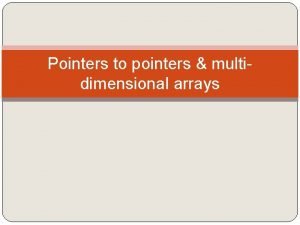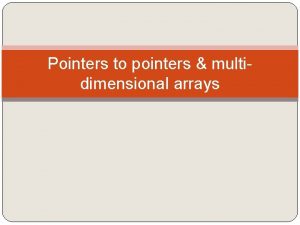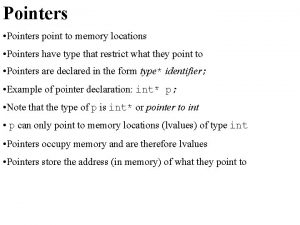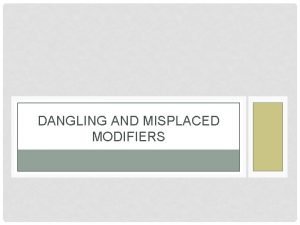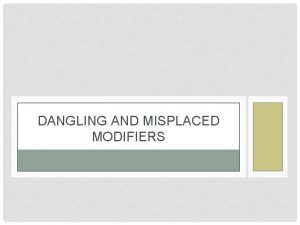Memory Leaks and Dangling Pointers Lecture 6 Thu










- Slides: 10

Memory Leaks and Dangling Pointers Lecture 6 Thu, Jan 29, 2004

Topics l Memory Leaks l Dangling Pointers l The Vector class Set. Size() function l The Vector class Input() function l Constructors and the new Operator

Memory Leaks l. A memory leak occurs when all pointers to a block of allocated memory have been lost. l Leaked memory cannot be accessed or reallocated. l Excessive memory leaks may cause the program to run out of usable memory and crash. l Memory leaks should always be avoided.

Example: Memory Leaks l Leak. cpp

Dangling Pointers l l l A dangling pointer is a non-null pointer that points to unallocated memory. Dereferencing a dangling pointer may cause the program to crash. It impossible to test a pointer to see if it is dangling. Always set pointers to NULL if they do not point to allocated memory. Dangling pointers must always be avoided.

Example: Dangling Pointers l Dangle. cpp

Example: Vector: : Set. Size() l The Set. Size() function of the Vector class must ¡ Allocate new memory of the specified size. ¡ Copy the old values into the new memory. ¡ Deallocate the memory that the Vector is currently using. ¡ Redirect the Vector to the new memory.

Example: Vector: : Input() l Example: vector. h, vector. cpp, Vector. Test. cpp

Example: Vector: : Input() l The Input() function of the Vector class must ¡ Deallocate the memory that the Vector is currently using (if any). ¡ Allocate new memory for the values to be input. ¡ Continue to increase the allocated memory as more values are read.

Constructors and the new Operator l The new operator is used in conjunction with the constructors. int* pi = new int(123); string* ps = new string("Hello"); Rational* pr = new Rational(2, 3); Date* pd = new Date("Jan", 23, 2002); Point* ppt = new Point; int* pai = new int[123]; Point* papt = new Point[10];
 Purify memory leak tool download
Purify memory leak tool download Thú mỏ vịt được xếp vào lớp thú vị
Thú mỏ vịt được xếp vào lớp thú vị Memory leak and dangling pointer
Memory leak and dangling pointer Numberblocks leaks
Numberblocks leaks Xenon leak
Xenon leak Leak qc of
Leak qc of Sandra adamsson leaks
Sandra adamsson leaks 01:640:244 lecture notes - lecture 15: plat, idah, farad
01:640:244 lecture notes - lecture 15: plat, idah, farad Shape memory alloys lecture notes
Shape memory alloys lecture notes Internal memory and external memory
Internal memory and external memory Primary memory and secondary memory
Primary memory and secondary memory













